Corey Strange
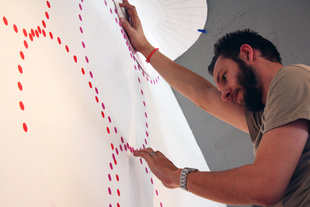
How did you get started with art?
Academically, it wasn’t until I was nineteen and graduating high school. It was in the summer of 1996 that I had my first art class at a local community college in Southern California. As with all my formal education, learning art was a matter of being exposed to other artists and having the time to focus on personal expression. Never in all my student years did a teacher say, “This is how you mix paint. These are the elements of good design. This is a better way to get your proportions right.”
Community college lasted for a year before I got sidetracked and discouraged. In August of 2001 I decided to go to art school and commit to a full-time art education. The pain of not making art had finally exceeded the fear of making it. It was time to see what I was really made of.
Informally, I began my art career as soon as I could hold a crayon. At the advice of a friend from church my parents had me tested as a gifted child at two years old. Ironically, at least part of the test was drawing circles which is now the major thrust of my work.
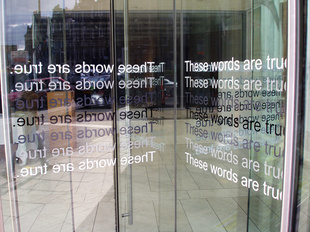
What led you to focus on conceptual art?
I wouldn’t say that I’m a conceptual artist or what I do is conceptual. The art I make happens to have a heavy dose of concept behind each piece but the visuals don’t take a back seat to it. The visuals are designed to help guide the viewer to the meaning. Sometimes that’s very specific, like when I use black against white, but other times—when I use colors, for example—the reference may be more subjective in its interpretation. It’s an approach that assumes a lot of responsibility for the audience’s participation and I have to accept that the work is generally obscure to most people. That’s why I try to do a lot of talking about the work when I have a chance. The work then becomes a bridge for mutual education and discussion between the public and me.
When I first started my undergrad program, I was stuck somewhere between figure and abstraction. After feeling super depressed at not being able to hold a candle to other kids’ figures, I realized that making art is about making your own rules. Once I made the game my own, I always gravitated towards abstraction of one kind or another. Everything I put out there is an authentic extension of myself and generally orbits themes of spirituality. All of my work is an ever-expanding circle. Everything is connected in some way. In a big picture, it’s the story of all life, light and truth. Call it conceptual if you want. It’s all just a big self-portrait, an externalized manifestation of a spiritual state of being.
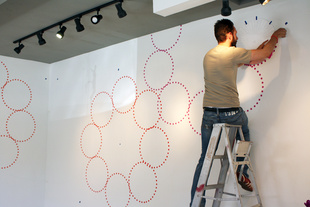
What is the connection between your work and the abstract symbols we see in and on temples?
My aunt saw one of my t-shirts with a white circle on the front. When I told her it was my art she said, “Well it’s just a circle! I could do that!” She’s right, but that’s not the point. Can you think about a circle? Can you really think about it?
Go to the Salt Lake Temple. Circles are everywhere! Absolutely everywhere. Why? Decoration? Sure. Only decoration? No. The Lord works on multiple levels whereas we tend to see things one-dimensionally. A circle in an LDS temple means a lot of things, which is my point. A circle on a t-shirt may not have the same reading at first, but to me, whether on the shirt or on the temple, a circle means the same thing and not the same thing at the same time.
The work I make uses symbolic everything. Shapes, colors, context, etc., are all conceived and critiqued by me using symbolic references. In that way, I’m bringing the temple into the outside world. The work, like the temple, is a way of bridging the divine with our “everyday” lives. This is what God does with us all the time. He gives us symbols such as the sacrament or temple garments that are reminders of a transcendent truth in order to bring heaven down to earth and elevate earth up to heaven. This is the meaning of the Star of David with its two opposing triangles. The overlapping area is where Saints reside—between natural and spiritual man, between heaven and earth.
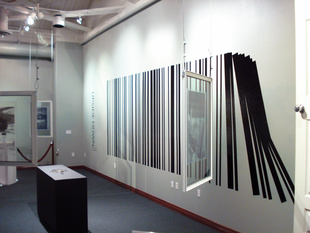
What power does art have?
The power of any art is threefold. First, it has the capability to transmit ideas and feelings straight into our spirits and thereby alter our consciousness. This happens on any scale you can imagine: individual, community of various sizes, nationally, and the world at large. This is the second part: its unifying power via the collective human experience. The third part of its power lies in the fact that after it has united the hearts and minds (in that order) of the people, they can then be steered according to the wishes of whoever is in power.
This power of art is always neutral. Its fruits depend on the purposes of whoever is doing the steering. Power derived from and directed by arts’ unifying force was wielded by the Nazis and by the Latter-day Saints.
Think of pioneers pulling handcarts into the unknown, singing, “Come, come, ye Saints, no toil nor labor fear,” and how those songs united and solidified them then. Think of singing those same refrains in one of our General Conference sessions, knowing that Saints all over the world are singing those same sweet words at the exact same time. And not only we who are seen but imagine all those who are unseen singing right along with us. Our hearts become welded to theirs through this shared experience made possible by art. From this connection, the Lord guides and directs His work with love on both sides of the veil. “If ye are not one, ye are not mine.”
I must also warn that the most powerful form of mind and behavioral control is the kind where the one being controlled is ignorant of it. Then they can be used and not even resist if they ever had a mind to. The question of beauty is knowing what is really behind the mask. Those alluring aesthetics may be hiding a subtle deception or expressing a divine light. What is the message (the seed) and what are its unforeseen or unintended consequences (the fruit)? Remember that Christ himself had “no beauty that we should desire him.” A spoonful of sugar makes both the medicine and the poison go down.
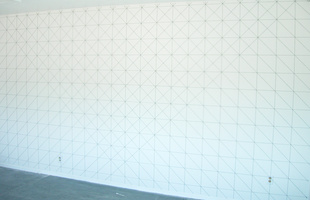
What do you want your audience to experience when they see your art?
That’s an easy one! A profound paradigm shift in every possible way, mostly toward a greater sense of God in every thing and situation.
A good illustration of my ideal situation comes from when I was living in New York City. I was transporting a piece of artwork on the subway. The image was red text saying “I DON’T KNOW. ” Within the phrase some of the letters are printed half-tone so they dissolve and you can also read “I DO NOW. ” A young lady was sitting across from me and out of my periphery, I could see she was studying the piece very intently. This went along for a couple stops but I didn’t say anything. I wanted to see if she would have the experience. All of a sudden she clapped her hands and almost shouted, “I got it!” Quickly I turned to face her and she was beaming, like she was really enlightened. She was lighting up right there on the subway! She was practically giddy as she explained to me what she was seeing in my piece. Turns out she’s a yoga instructor, which is right up my alley. She brought up yin and yang and eternal cycles, knowledge leading to a greater understanding of our ignorance leading to epiphanies, and so on. It was really beautiful and we were elated to be sharing such a beautiful moment together. She loved it so much I just gave her the piece right there.
What did I need money for when this person had given me the greatest experience an artist can have? That zap! pow! connection is rare. It’s an ideal but it’s what I hope for, in some way, every time.
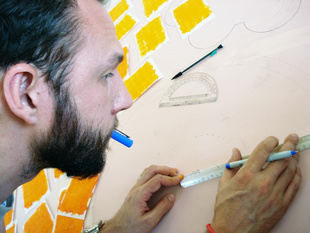
What place does your art have in Mormon culture?
I think a very important place. The symbolism I use can be used to illuminate gospel principles in general and the temple and scriptures more specifically. Metaphors and symbols are the universal visual language but even as rich as our LDS heritage is in symbolism, we are largely ignorant to its meaning, implication and application in our lives. To that end, I think my work is very applicable in a metaphysical sense to unite people together and move the cause of truth and liberty.
In a broader scope, I also think part of my place is to teach people how to think abstractly in order to see more of the glory of God in “everyday life”. As we think more broadly, our net is cast wider and can pull in more light and truth. As we study to become like God, shouldn’t we begin to see the world in this way? The universe is the greatest textbook ever created. Mormons should be at the forefront of all godly pursuits. President Taylor and Kimball have said that we will be. In order to get to that place, we as a people will need a massive paradigm shift.
I see myself and my art as building bridges to unite the world with the church and vice versa. We are unified in many of the negative vices the world has to offer but we too often deny the wisdom and blessings the rest of the world cherishes. So it’s my attempt to unify and elevate all people in the world by sharing the best of what the other has to offer through my art, life and education practices.
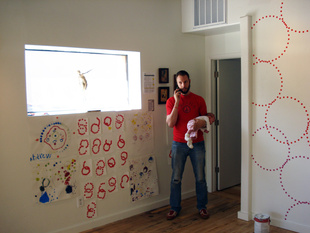
How has the gospel influenced your work?
Everything I learn in life, I funnel through the gospel filter, and usually that expresses itself in artwork. It’s a great way to externalize and practice the things I learn. Other artists will attest that their work is also a great way to learn about the gospel. I find that God often teaches me profound truths through my own artmaking processes. Basically, there is no other influence on my work greater than God.
Some of your pieces (especially the barcode pieces) make specific truth statements. How have people reacted to this?
The barcode that showed at the St. George Art Museum had lots of great responses on the guest register. The domino effect of the some bars toppling over against the adjacent ones had a real impact on people. I think it illustrated what we’re all feeling at the moment; that sort of breathless anticipation of waiting for the ball to drop. You can see the beginnings of its demise coming towards the pristine yet delicately balanced economics further down the line. It was an ominous and foreboding kind of barcode. Generally, I don’t like doom-and-gloom, but under the circumstances, I think it’s appropriate. I was just happy that people resonated with it.
Other pieces are more abstract, such as the circles. Do you view both projects (specific vs. abstract) as one and the same, or do you see them as two separate projects? How are they related?
Perhaps it’s not that I see them as two separate projects so much as two different working styles…but you could also say they are both about the same issues, in a way—uniting to defend truth and liberty.
The more specific works using barcodes, red flags, and text make statements that are persuasive in nature. They are designed with a very particular outlook on our current state of affairs with a very definite hope that people will see things a certain way through the artwork and decide to make a stand against evil.
The circles are another way of persuading people to unite to fight for what’s good, but it’s more of an “invite and entice” approach rather than “repent or die.” This shift towards a softer sell happened when I understood that liberty’s foundation is virtue, and virtue, in its highest degree, cannot be obtained without faith in Christ. So in order to pursue the defense of liberty I am fighting the battle for virtue…with circles.
I know it’s funny when put like that, but you have to understand that the circles mean for me, among other things, a representation of the good news of Jesus Christ and all good things surrounding Him. So the tone has changed from “This is bad. This should stop,” to “This is good. We need more of this. This is what we should be focusing on.” Joseph Smith translated the word “Mormon” as “more good.” The Spirit has taught me that it’s not just about weeding out the bad, but about replacing those bad things with more and more goodness. There’s a time to call for repentance, but the standard operating procedure is to uplift and inspire. That’s “Mormon.”

How was your experience studying in Scotland? Would you recommend the experience to other artists?
It was a very, very difficult experience for a lot of reasons. Basically, all my romantic expectations were flushed away within a few days. No studio, no classes, no critiques, no facilities to speak of, no visa, no money to live on or make work, and the list goes on.
So I couldn’t recommend the experience per se, but for me, it was just what I needed. To be humbled and impoverished with only a local bishop and ward for support was the only way that I could get reactivated in the Church. In the space of about two weeks I went from eight years of complete inactivity and opposition to the Church to being absolutely on fire for the Lord and his gospel. That is an experience I will highly and enthusiastically recommend!
Tell us about your “Infinite Hymn” piece at the St. George Art Academy.
That piece came about at the request of the wonderful women at the St. George Art Academy. This was the first show in their new gallery space in downtown St. George.
Since they use their gallery as an educational space for classes, it was the perfect opportunity to combine my work with the educational angle that has become so integral for me since 2006. They wanted a piece that was contemporary and that could be in process in order to facilitate discussion with students and the general public. They wanted something different than the redrock/blue sky that dominate southern Utah galleries.
Besides that foundation, the piece (for me) is about micro and macro processes of the universe. You might say it’s derived from string theory in some ways and music theory in others. Tones and rhythms falling together, apart, together again. It is fundamentally the music and dance of creation. I think of the dots as both musical notes and markings of a dance pattern. There was a high degree of math involved which people picked up on. There’s also the playful aspect to it. So many people said it would look great in their kid’s playroom. How’s that for conceptual art?
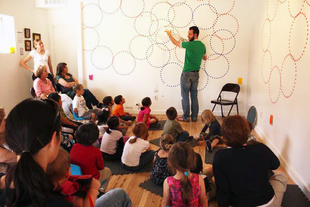
Tell us about “Upside Down,” your barcode artwork at the St. George Art Museum.
“Upside Down” was a collaboration I did with Kathy Cieslewicz, the curator at Dixie State College. She presented me with the opportunity to work together and have a beautiful space at the museum back in 2009. She said at the first that she wanted one of my barcodes in the exhibit since the installation was addressing the country’s economic distress.
“Upside down” is the phrase used when someone owes more on their house than it’s worth. In a simplistic sense, the backlash from that economic/housing crisis is the issue that kicked off our economic meltdown today. I wanted to address that idea but wasn’t sure how. By sheer providence, I was inspired halfway through the bar installation to make the right side of the code start crumbling and toppling into the left side like a line of dominos. The impact of seeing that ripple effect was quite moving. It really captured the impending doom sensation that seems to be growing in the country and the world.
Why barcodes?
In some ways, they are the perfect ready-made abstraction in our postmodern world. At first they were an exercise in self-referential art (they were masking tape barcodes in the form of their own barcodes). That was a fun little circle and a difficult thing to pull off in its purity. Then a friend told me that you can create your own custom barcodes, so I turned them into self-portraits using my birth year, month, day, hour and minute.
Abstract self-portraits that are really objective but in a different language is another fun twist. Since then I found a site that will create custom barcodes in numeric and alpha code, so I started taking famous or infamous quotes and turned them into barcodes. Each one says something specific that relates to the visual twist I’m putting it.
Barcodes also have such a powerful connection to dehumanizing practices—making everyone the same, mark of the Beast, New World Order, etc. They’re such a loaded image and beautiful in their minimalist sensibilities. Their connotation does a lot of the work for me, which makes the work more effective, I think.
What tools do you use to make your pieces?
Oh man, I’m all over the place! The typical painting supplies, lots and lots of sticky things like masking tape, pin striping tape of various sizes, office stickers and sign vinyl. A self-leveling laser level and this special compass which can make circles as large as you want to go have been absolutely indispensable. That’s the standard list for any project these days.
In addition to those tools I throw myself a curve ball and bust out the phone video camera and sound recorder, Microsoft Word’s drawing tools and the ever-handy Adobe Photoshop and Illustrator.
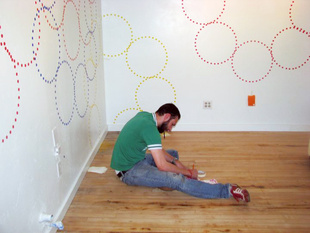
Any words of advice for other artists?
To anyone thinking of pursuing an art school education: Spend as much time at the school as possible and ask yourself a lot of hard questions about everything from living fiscally provident to what the local ward is like. Will your weaknesses be easily preyed upon at school? Art schools have a reputation for a very good reason. Will you get to make the art you want to? Are their resources able to meet your creative capabilities? Will you be challenged? Will you get to go home enough so you don’t get depressed? Will you have a good spiritual support network? Is your testimony strong enough to stand alone in such an opposing peer group? If not, what can you do to bolster it so you can stand up to opposition? What is on your priority list for school? Are spiritual considerations on the top of that list? It is better for a man or woman to enter into the kingdom halt, maimed, blind, and without a higher art education than to lose their soul in the process.
As a married man in Zion, I understand the frustration of being an artist and the frustration that comes of trying to find work in this economy, finding work in crumby jobs that suck your will to live and leave you unfulfilled, and the gut-wrenching emotional wrestling match of negotiating your internal drive to both make art and fulfill your command to support your family. It’s tough, but every artist-father family I know will tell you amazing stories of how the Lord provides for his children as they are living their missions in life.
Whatever seed he has planted in your heart to do, he will provide a way for you to live it out. “I know that the Lord giveth no command unto the children of men save he shall prepare a way to accomplish his command.” That desire is how you will serve the world and find joy in your labors in this life. I had to work a lot of jobs I didn’t want to and felt like a failure, but it was all part of my curriculum to get me together with the one woman in my life who believed that God would take care of us if we lived on faith and followed his commands.
Don’t wait to have children until the finances are “okay.” I was unemployed for eight months when we decided to have kids. After we dedicated ourselves in prayer, my wife and I stood up and less than a minute later I got a call asking me to teach at Southern Utah University. We have several other friends with similar stories.
I wouldn’t dream of telling you what to do with your artmaking pursuits, but please don’t compromise your desires to make “impractical” art that “won’t sell” to make art that is more sensible and salable. Think of Isaiah: “Why do you sell yourself for that which is of no worth?” and Lehi: “If ye keep my commandments ye will prosper in the land.” ❧
